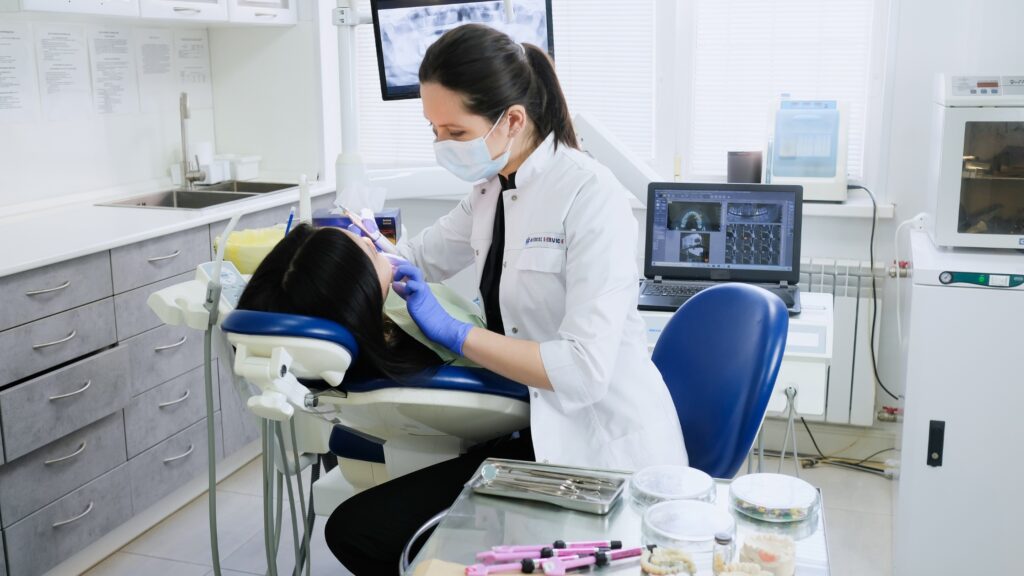
Dosimeter badge services for medical, dental, and veterinary businesses
Learn how Radiation Detection Company’s easy-to-use dosimetry solutions can boost the efficiency of your practice.

Dosimetry Consultant
Last Updated: August 19, 2024
Explore common sources of radiation in dental practices, why wearing a radiation badge is necessary, which staff members should wear badges, and best practices for accurate badge usage.
X-rays are a daily occurrence for both dentistry staff and patients. To help keep your dental staff safe, measuring their exposure to radiation is vital. As long as you follow safety protocols, occupational exposure should be minimal. Investing in a radiation badge service to track staff exposure is essential for ensuring proper exposure management and radiation compliance.

Below, we've included some of the most common radiation-emitting equipment staff may be exposed to in dental offices.
X-rays are the most common type of ionizing radiation. These machines emit a small amount of radiation – on average between 0.5-1 mrem per image. A full-mouth X-ray series (which includes 18 to 20 images) usually only delivers a dose of about 10-20 mrem.
Handheld X-ray devices emit a lower amount of radiation than traditional X-ray machines. These devices take X-rays of individual teeth or small areas of the mouth. On average, a handheld X-ray device emits between 1-5 mrem per image. However, handheld X-ray devices pose additional risks as personnel cannot distance themselves during exposure.

CBCT emits a higher amount of radiation than traditional X-ray machines. These machines produce 3-dimensional images of teeth, gums, and other oral structures. On average, a CBCT scan delivers a dose of 20-60 mrem per scan.
Curing lights emit a small amount of non-ionizing radiation. They are used to harden dental materials, such as fillings and sealants.
UV lights also emit a small amount of non-ionizing radiation. They are sometimes used to detect oral cancer or other issues.

Gamma radiation has proven to be an efficient way to sterilize extracted teeth, as alterations of dentin and the enamel mechanical properties are minimal.
Developing and implementing a radiation safety program and maintaining improved dosimetry compliance ensure that the documented occupational dose always remains within safe limits. A continuous radiation monitoring service can ultimately assist employers in limiting their exposure to liability in the workplace.

Minimizing radiation exposure also reduces the risk of long-term health effects (like cancer and other radiation-induced illnesses). When it comes to radiation exposure, ALARA is the most important acronym to know. It stands for “as low as reasonably achievable” – the goal of any radiation safety program is to keep radiation doses as low as reasonably possible.
When deciding who should wear X-ray monitoring badge in your practice, it’s key to look at who faces the most exposure to radiation.
Dentists and hygienists should wear dosimeter badges as they are most likely to work directly with X-ray machines or CBCT scanners (the primary sources of ionizing radiation in dentistry). Dental assistants should also wear them, as they may work in close proximity to these machines. Any staff handling or processing X-ray film and staff working in the processing area should also wear a badge to document radiation exposure and mitigate the risk.
Radiation badges are also important for any declared pregnant workers who will need a fetal monitor in addition to a personal dosimeter badge.
For a deeper look into how to handle, store, and wear an X-ray monitoring badge, plus insight on how to closely track exposure, access reporting, simplifying dose reads, and more, please refer to our article, Dosimeter 101: Instructions on Radiation Badge Use.

Every employee benefits from radiation monitoring because it empowers them to work with peace of mind, knowing their health is not at risk. The company also benefits since documented occupational dose monitoring protects against current and future legal health claims by an employee (so long as the owner can show documented evidence that their employees did not exceed their occupational dose limits during their term of employment). For this reason, companies should keep detailed dose records for the lifetime of the business.
Providing each staff member with a personal radiation dosimeter badge and entrusting a radiation monitoring service helps employers maintain lower dose thresholds, ensuring compliance and long-term well-being.
Whether you’re looking for an X-ray monitoring badges for dental offices or archeology, Radiation Detection Company is dedicated to keeping all employees safe from overexposure. We've provided the highest quality dosimetry service to over 31,000 companies worldwide over the last 75 years.
You can take the next step and secure radiation monitoring for your dental office today by visiting our Solutions page to browse our full suite of offerings. We offer a wide range of affordable and comprehensive dosimetry solutions to fit the needs of any organization, large or small.
If you have a question we did not address in this article, please reach out to our Customer Care team, and one of our specialists will be happy to assist you.
Yes, your state’s regulatory agency generally requires radiation badges in dental offices. Dentists, dental assistants, hygienists, and other staff are often exposed to ionizing radiation from X-ray machines used in diagnostic imaging. Dental offices must monitor radiation exposure levels to ensure employee safety and compliance with federal regulatory standards. Dosimeter badges help protect workers from excessive radiation exposure and ensure adherence to occupational safety guidelines set by regulatory bodies.
The cost of a radiation badge varies based on type and service provider. RDC believes in pricing transparency – get a dosimeter badge estimate in 3 minutes with our cost calculator.
Radiation monitoring companies can measure exposure using film badges, thermoluminescent dosimeters (TLD), optically stimulated luminescent dosimeters (OSL), and digital dosimeters like NetDose™ Dosimeter. The type of technology depends on your organization’s needs and the type of radiation-emitting equipment you use.
Need help choosing the best radiation badge for your organization? Call Radiation Detection Company at 512.831.7000 and get support today.
Learn how Radiation Detection Company’s easy-to-use dosimetry solutions can boost the efficiency of your practice.